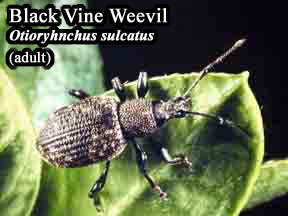Heather, Heath (Calluna, Erica)
Plant Health Problems
Once established, these plants are relatively disease-free.
Insect Problems: Black vine weevil, Otiorhynchus sulcatus.
Black vine weevil, Otiorhynchus sulcatus.
The larvae of this weevil often injure heath and heather in nurseries and ornamental plantings by feeding on the roots. The tops of injured plants first turn yellow, then brown, and the severely injured plants die. Leaf notching by adults can be unsightly. The 1/2" long adult weevil is black, with a beaded appearance to the thorax and scattered spots of yellow hairs on the wing covers. Only females are known. Adults are flightless and feed nocturnally. The legless grub is white with a brown head and is curved like grubs of other weevils. Adults and large larvae overwinter, emerging from May - July. The adults have to feed for 3-4 weeks before being able to lay eggs. Treating the soil with insect pathogenic nematodes may control the larvae and should be the first line of defense for landscape plantings. Acephate and fluvalinate are among the compounds registered for control of this pest in Connecticut, and may be applied when there is adult feeding and before egg laying starts. The usual timing for these foliar sprays is during May, June and July at three week intervals. Insecticide resistance is very common; be aware that adults may appear to be dead following contact with fluvalinate, but may recover from poisoning within a few days. Consult the labels for dosage rates and safety precautions.
Oystershell scale, Lepidosaphes ulmi.
This and other scales feed on heather. See Apple for a description of this pest and its life cycle. When needed, apply malathion or horticultural oil, which are among the compounds registered for control of this pest in Connecticut, in late spring when crawlers are present. Consult the label for dosage rates and safety precautions.

